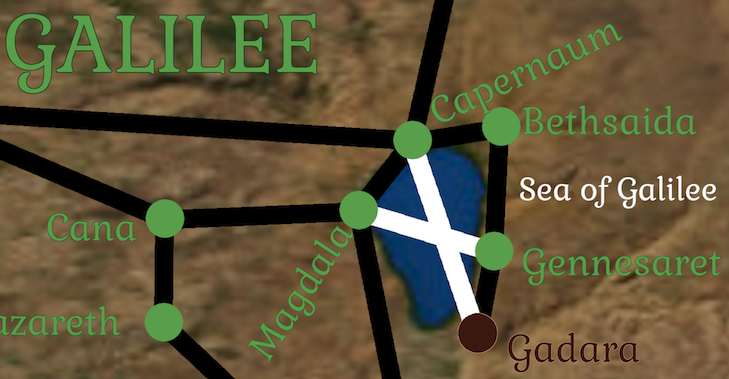In my last post, Jesus traveled from the River Jordan to Cana where He, His mother, and His disciples went to a wedding, and Jesus performed His first miracle. Staying in the gospel of John, we aren’t told much about His next journey:
After this, he went down to Capernaum, he, and his mother, his brothers, and his disciples; and they stayed there a few days. (John 2:12)
Cana and Capernaum are both in Galilee, so the journey was not extraordinary – about 20 miles. Probably a full day’s journey, but nothing like going to Judea.
On this trip, they only stayed a few days, but before long Capernaum would become the main base for Jesus’ ministry, so it’s worth taking a closer look at this fishing village.
Capernaum is on the northern shore of the Sea of Galilee. The location of Capernaum is significant for two main reasons. First, it gave Jesus easy access to all of the villages around this large lake. Second, Capernaum is on the Via Maris (or the Way of the Sea), the main highway connecting Africa to Asia and Europe (and thus connecting the Gentile world).
In fact, Matthew emphasizes that Jesus’ move to Capernaum specifically fulfilled Isaiah’s prophecy that “the way of the sea” would play an important role in the spread of the gospel:
And leaving Nazareth, He came and dwelt in Capernaum, which is by the sea, in the regions of Zebulun and Naphtali, 14 that it might be fulfilled which was spoken by Isaiah the prophet, saying:
15 “The land of Zebulun and the land of Naphtali,
By the way of the sea, beyond the Jordan,
Galilee of the Gentiles:
16 The people who sat in darkness have seen a great light,
And upon those who sat in the region and shadow of death
Light has dawned.”
17 From that time Jesus began to preach and to say, “Repent, for the kingdom of heaven is at hand.”
(Matthew 4:13-17)
In Matthew 9:1, Capernaum is referenced as Jesus’ “own city”, but in Matthew 11, he curses the place:
“You, Capernaum, who are exalted to heaven, you will go down to Hades. For if the mighty works had been done in Sodom which were done in you, it would have remained until today. 24 But I tell you that it will be more tolerable for the land of Sodom on the day of judgment, than for you.” (Matthew 11:23-24)
Jesus would perform many miracles in Capernaum (e.g. Luke 7:1-10; Matthew 8:14-15; Matthew 8:16-17; Mark 2:1-12), and many of Jesus’ disciples were from Capernaum. John, James, Peter, and Andrew were all fishermen in Capernaum (Matthew 4:18-22), while Matthew was a tax collector at a tax booth in Capernaum (probably along the Via Maris) (Matthew 9:9; Luke 5:27) .
So, it sounds like Capernaum was a very significant city in the region. It was strategically located, but there was a more important city on the shores of the Sea of Galilee. Moving down the western side of the lake you would come first to Magdala and then to Tiberias. Both were Roman cities. Tiberias specifically had been built by Herod Antipas in A.D 18 or 19 and made the capital of Galilee. According to The Wycliffe Historical Geography of Bible Lands, Jews considered Tiberias to be an unclean city, so it was purely populated by Gentiles. Tiberias is only mentioned in passing in the New Testament.
But what is great in the world’s eyes is often not what God will use greatly in bringing about His will.
Capernaum will feature prominently in many of the journeys we will discuss in future posts, but at this point in His ministry, Jesus spends only a few days in the village.
—
The map at the top of this post is a snapshot of a portion of the current prototype gameboard for Journeys with Jesus.
If you’ve found this interesting and would like to continue to read these stories of the journeys and places in Journeys with Jesus, sign up in the sidebar to receive updates.
Note: all scripture quotes, unless otherwise noted, are from the World English Bible which is in the public domain.

